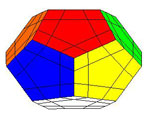The
previous post in this sequence was [moduli spaces][1]. Why did we spend
time explaining the connection of the quiver
$Q~:~\xymatrix{\vtx{} \ar[rr]^a & & \vtx{} \ar@(ur,dr)^x} $
to moduli spaces of vectorbundles on curves and moduli spaces of linear
control systems? At the start I said we would concentrate on its _double
quiver_ $\tilde{Q}~:~\xymatrix{\vtx{} \ar@/^/[rr]^a && \vtx{}
\ar@(u,ur)^x \ar@(d,dr)_{x^*} \ar@/^/[ll]^{a^*}} $ Clearly,
this already gives away the answer : if the path algebra $C Q$
determines a (non-commutative) manifold $M$, then the path algebra $C
\tilde{Q}$ determines the cotangent bundle of $M$. Recall that for a
commutative manifold $M$, the cotangent bundle is the vectorbundle
having at the point $p \in M$ as fiber the linear dual $(T_p M)^*$ of
the tangent space. So, why do we claim that $C \tilde{Q}$
corresponds to the cotangent bundle of $C Q$? Fix a dimension vector
$\alpha = (m,n)$ then the representation space
$\mathbf{rep}_{\alpha}~Q = M_{n \times m}(C) \oplus M_n(C)$ is just
an affine space so in its point the tangent space is the representation
space itself. To define its linear dual use the non-degeneracy of the
_trace pairings_ $M_{n \times m}(C) \times M_{m \times n}(C)
\rightarrow C~:~(A,B) \mapsto tr(AB)$ $M_n(C) \times M_n(C)
\rightarrow C~:~(C,D) \mapsto tr(CD)$ and therefore the linear dual
$\mathbf{rep}_{\alpha}~Q^* = M_{m \times n}(C) \oplus M_n(C)$ which is
the representation space $\mathbf{rep}_{\alpha}~Q^s$ of the quiver
$Q^s~:~\xymatrix{\vtx{} & & \vtx{} \ar[ll] \ar@(ur,dr)} $
and therefore we have that the cotangent bundle to the representation
space $\mathbf{rep}_{\alpha}~Q$ $T^* \mathbf{rep}_{\alpha}~Q =
\mathbf{rep}_{\alpha}~\tilde{Q}$ Important for us will be that any
cotangent bundle has a natural _symplectic structure_. For a good
introduction to this see the [course notes][2] “Symplectic geometry and
quivers” by [Geert Van de Weyer][3]. As a consequence $C \tilde{Q}$
can be viewed as a non-commutative symplectic manifold with the
symplectic structure determined by the non-commutative 2-form
$\omega = da^* da + dx^* dx$ but before we can define all this we
will have to recall some facts on non-commutative differential forms.
Maybe [next time][4]. For the impatient : have a look at the paper by
Victor Ginzburg [Non-commutative Symplectic Geometry, Quiver varieties,
and Operads][5] or my paper with Raf Bocklandt [Necklace Lie algebras
and noncommutative symplectic geometry][6]. Now that we have a
cotangent bundle of $C Q$ is there also a _tangent bundle_ and does it
again correspond to a new quiver? Well yes, here it is
$\xymatrix{\vtx{} \ar@/^/[rr]^{a+da} \ar@/_/[rr]_{a-da} & & \vtx{}
\ar@(u,ur)^{x+dx} \ar@(d,dr)_{x-dx}} $ and the labeling of the
arrows may help you to work through some sections of the Cuntz-Quillen
paper…
[1]: http://www.neverendingbooks.org/index.php?p=39
[2]: http://www.win.ua.ac.be/~gvdwey/lectures/symplectic_moment.pdf
[3]: http://www.win.ua.ac.be/~gvdwey/
[4]: http://www.neverendingbooks.org/index.php?p=41
[5]: http://www.arxiv.org/abs/math.QA/0005165
[6]: http://www.arxiv.org/abs/math.AG/0010030
 In a few
In a few